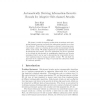Free Online Productivity Tools
i2Speak
i2Symbol
i2OCR
iTex2Img
iWeb2Print
iWeb2Shot
i2Type
iPdf2Split
iPdf2Merge
i2Bopomofo
i2Arabic
i2Style
i2Image
i2PDF
iLatex2Rtf
Sci2ools
JCS
2011
2011
Automatically deriving information-theoretic bounds for adaptive side-channel attacks
We present a model of adaptive attacks which we combine with information-theoretic metrics to quantify the information revealed to an adaptive adversary. This enables us to express an adversary’s remaining uncertainty about a secret as a function of the number of interactions with the system under attack. We present algorithms and approximation methods for computing this function. The main application area for our approach is the analysis of side-channels in cryptographic algorithms and we give examples of how it can be used to characterize the vulnerability of hardware implementations to timing and power attacks. We also show the generality of our approach by using it to quantify the information leaked by a security protocol.
| Added | 14 May 2011 |
| Updated | 14 May 2011 |
| Type | Journal |
| Year | 2011 |
| Where | JCS |
| Authors | Boris Köpf, David A. Basin |
Comments (0)

